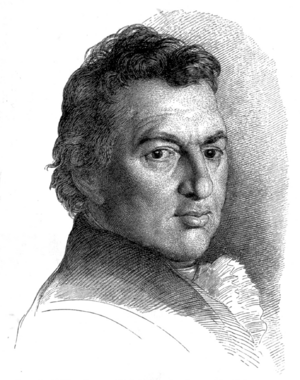Wilson Lowry facts for kids

Wilson Lowry (born January 24, 1762 – died June 23, 1824) was a talented English engraver. An engraver is an artist who creates pictures or designs by cutting lines into a hard surface, often metal plates, to then print images. He was also a Fellow of the Royal Society, which is a special honor for important scientists.
Contents
Early Life and Training
Wilson Lowry was born in Whitehaven, a town in Cumberland, England. His father, Strickland Lowry, was a portrait painter. The family later moved to Worcester. When Wilson was a boy, he left home to work as a house painter in London and Arundel, Sussex.
After returning home, he learned some engraving skills from a local craftsman. At 18, he moved to London. There, he met John Boydell, a print seller who gave him work. Boydell also introduced him to William Blizard, a surgeon. Blizard encouraged Lowry to study surgery, and he trained for four years. However, he decided not to become a surgeon in the end.
Innovations in Engraving
Lowry studied engraving under John Browne, who was known for landscape engravings. He also trained at the Royal Academy Schools. Lowry was very inventive and created several special tools to help with his work.
- Around 1790, he invented a machine to make straight lines.
- In 1801, he created a device for drawing oval shapes.
- In 1806, he made another tool for creating perspective drawings.
Lowry was also the first engraver to use diamond points for cutting. He also discovered a special liquid that could "bite" or etch lines into steel plates. This made engraving much more precise and efficient.
Famous Works and Contributions
Lowry was especially good at engraving pictures of buildings and machines. He was known for his detailed perspective views of machinery. His work appeared in many important publications of his time.
- He contributed to Tilloch's Philosophical Magazine and the Journal of the Society of Arts.
- His engravings were in books like Wilkins's Magna Graecia (1807) and Vitruvius (1812).
- He also worked on Peter Nicholson's Principles of Architecture (1795–98) and Architectural Dictionary (1819).
- Other works include George Crabb's Technological Dictionary (1823) and the Encyclopædia Metropolitana.
Lowry's most famous work was for Rees's Cyclopædia between 1802 and 1819. He not only created engravings but also wrote articles for this large encyclopedia. He also contributed to other encyclopedias like Pantologia and the British Encyclopedia, or Dictionary of Arts and Sciences.
Achievements and Family Life
Wilson Lowry was a founding member of the Geological Society. This society studies the Earth's rocks and history. In 1812, he was elected a Fellow of the Royal Society, a very high honor for scientists and innovators. He passed away at his home in Great Titchfield Street, London.
Lowry was married twice. His first wife was a Miss Porter. They had two daughters. One daughter, Matilda, became a portrait painter.
His second wife was Rebecca (1761–1848), a mineralogist. She came from a Sephardic Jewish family of snuff and tobacco merchants. Rebecca's sister was the mother of the famous economist David Ricardo. Wilson and Rebecca had a son, Joseph Wilson Lowry, and a daughter, Delvalle Lowry. Delvalle later married John Varley, a well-known landscape painter.

